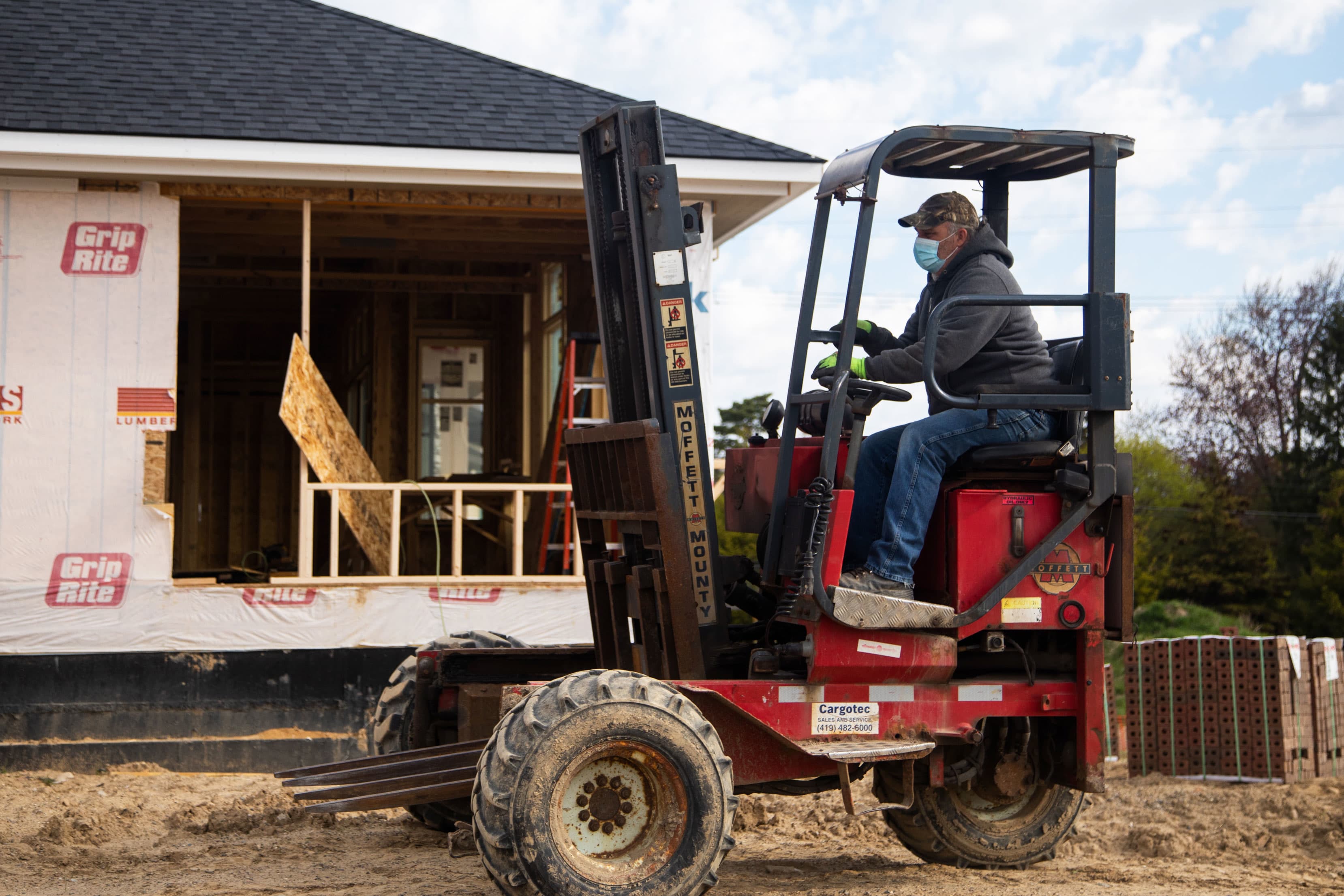A construction worker wearing a protective mask moves bricks to the back of a house as they resume construction on a home in Bloomfield Hills, Michigan, May 7, 2020.
Emily Elconin | Bloomberg via Getty Images
It is the perfect storm for the nation’s homebuilders. A sharp decline in the supply of existing homes for sale, increasing consumer preference for brand-new, high-tech homes with all the amenities for working and schooling, as well as an accelerating flight to the suburbs and exurbs made for remarkable housing demand in June.
While the official government count isn’t out until the end of the month, sales of newly built homes jumped 55% annually in June, according to a monthly survey by John Burns Real Estate Consulting, which has historically mirrored the U.S. Census report. It was the largest annual gain since homebuilding began again following the epic housing crash a decade ago.
It is also the highest pace of sales growth since the height of the unprecedented housing boom in 2005. That expansion was driven by negligent lending in the subprime mortgage market. This boom appears to be driven by the coronavirus pandemic.
“The anecdotal evidence is overwhelming. Sales in the distant commuter areas are the most robust,” said John Burns, founder and CEO of JBRC. “I believe a lot of computer-oriented people have proven to their co-workers that they can be productive from home, and have sensed, or officially been given the green light, to work from home at least a significant portion of the time after a vaccine has been found.”
That sentiment was mirrored in a survey by Arizona-based builder Taylor Morrison, which reported a 94% annual jump in June home sales. High-tech homes, and additional rooms for working and home schooling, topped the list of consumer demands.
“There is a bias to new. When I look at the research that our teams have been doing over the last 12 to 14 weeks, people are quoting, they want new, fresh, a place where wellness features will really make sense for them,” said Sheryl Palmer, CEO of Taylor Morrison recently in an interview on CNBC’s “Closing Bell.” “Most recently, we’re really seeing a pickup in folks saying they want more rural or suburban locations. Initially, there was a lot of talk about that, but it’s really coming through our buyers today.”
Sales of new homes were strongest in the Northeast, with an 86% annual jump, and in Florida, where sales popped 84%, according to JBRC. California saw gains, but it was the laggard.
Those sales are allowing builders to raise prices. About 57% of those surveyed said they had bumped prices higher, only in California did prices pull back some. About 14% of Southern California builders reduced net prices in June, the most of any region. Nationally, home prices for new construction in June were 4.5% higher annually.
Builders can raise prices because they are seeing a new buyer today, more serious and more impatient than ever. Buyer traffic is converting into sales at a record rate. In addition, consumers are largely choosing homes already built, even in the luxury segment. That is why the inventory of unsold, newly built homes dropped 20% annually in June to just a 1.5-month supply.
The issue for builders now is how to ramp up production quickly, when they never expected this kind of recovery. Most builders stopped buying land in March and laid off workers. Now they need more communities but are up against all kinds of hurdles, including high prices for finished lots and issues with local permitting offices which are not all open or running normally yet.
Land developers will benefit, as community counts are now 5% lower than a year ago. There is, of course, the Covid-19 wild card: If the economy shuts down yet again, and unemployment rises, the prospects for housing strength continuing into the fall will weaken. Record low mortgage rates are certainly helping, but at some point, buyers will inevitably hit their price limit. Already, in the high-priced existing home market, there are signs that demand is pulling back.

 breakout perfect entry #forex #crypto #trading #trending
breakout perfect entry #forex #crypto #trading #trending

 RULE-BASED Pocket Option Strategy That Actually Works | Live Trading
RULE-BASED Pocket Option Strategy That Actually Works | Live Trading This “NEW CONCEPT” Trading Strategy Prints Money!… (INSANE Results!)
This “NEW CONCEPT” Trading Strategy Prints Money!… (INSANE Results!)